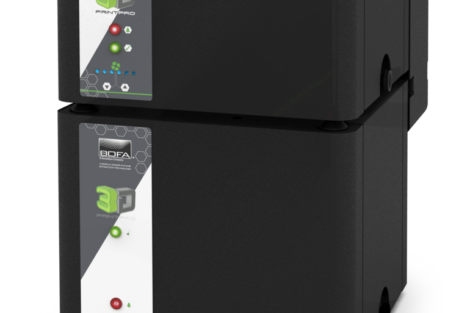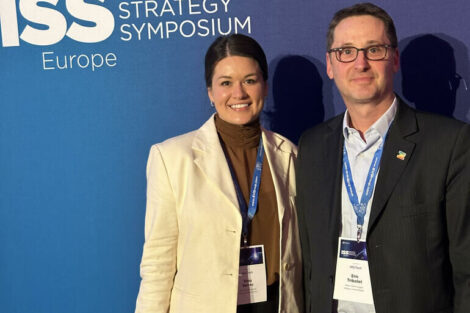With two series of placement machines, Siemens Dematic has brought new Siplace equipment for both the mid-level and the highly flexible markets up to the international assembly community. This despite the flat overall economy, making it therefore act strictly anti-cyclic. ”The current crisis didn’t really weaken us”, Dr. Peter Drexel, member of the Siemens managing board, underlined with emphasis, ”we are instead stronger now than before. And one thing is for sure: we won’t give up our positions, but will continually provide solid ground for our even more energetic activities”.
The globally present Siemens Dematic group is engaged in three different main markets, and claim to have a leading position in each of them, which are material handling automation, postal automation and electronics assembly systems (EA). Sales in the last financial gained up to 53% in the Americas, up to 36% in Europe and up to 10% in Asia. Revenues accounted for approximately euro 3bn. The group has some 11,000 employees worldwide. In total, the EA division, which is of special interest here, has installed more than 11,350 machines worldwide at about 1,900 customer’s sites. Even during the dramatic downturn in 2001/2002, where the world market for high-performance surface-mount equipment shrank from about $3.8bn to 1.7bn, the Siplace company could not only keep its market share, but it even managed to enlarge from 24% to 27%, as Peter Völkl, director of global sales and marketing, underscored. At the same time, the practically comparable (in worldwide sales figures) two main competitors of Japanese origin went significantly down in sales, one to a mere 14%, the other to 18%, to widen the gap to the now leading Siplace brand even more. By the way, these global market figures stem from independent market researchers.
Expanded regional headquarters in Shanghai
According to Gerhard Ott, head of the EA division, the most machines were installed in Europe (60% or 7,050 pieces of equipment) at 1,200 customers, followed to almost equal shares by the Americas and Asia with each 20% (2,200 machines each, with at more than 700 customers in total). 90% of the EA revenues are being realized with placement equipment, the rest is precision mechanics as well as laser drilling and structuring machines. Currently, there are 2,000 employees worldwide. Besides the HQs in Munich, there are regional head quarters (Centers of Competence) in Atlanta (Americas), Singapore (South East Asia) and Shanghai for mainland China and Taiwan. From these central locations, support as well as service will be provided for these areas, backed by multiple service locations, training, support and R&D centers as well as engineering staffs.
In the worldwide electronics industry, as Peter Völkl explained, all regions – except China – have seriously suffered from the downturn in the time span between the end 2000 to middle of 2002, but best recovery could be found in Asia, followed by Germany. The steepest footfall had taken place in the U.S. from a very high level, where now the recovery is still relatively weak, but is expected to pick up. Western Europe is currently just a bit better positioned. In the markets, a shift to medium-speed machines is underway. When market researchers expect an average growth of 8.7% in overall placement equipment, the high-end section will move with 4.5%, but the middle segment is said to advance by 11.7%. The machine markets are very different. High-speed machines will perform the typical high-volume assembly tasks; in the middle section, the task is called high mix/small batches with an urge for high flexibility. And then we have the very small production runs, prototyping and the like where high flexibility is also an issue, but the throughput is not.
The market has started to recover
”The market has started to recover.” This is the very good news from Ray Bruce, European director of sales and service. Nevertheless, many used machines are on sale; equipment utilization is low but rising; investment is still being delayed; telecoms is still flat; and acquisitions, outsourcing and factory closures continue, but on a reduced level. A backbone of European electronics manufacturing is automotive electronics, accounting for about 20% of the total production volume (with slightly growing tendency); another 20% are made by industrial electronics and controls. Telecom is 15% (but was about 45% during the mobile telephone hype); IT, medical and consumer electronics are each in the range of about 8 to 12%. The European growth rate for assembly equipment during this year is estimated for about 3.6 to 7,1%, the variation depending on different market researchers. The current European market volume for SMD placement equipment is said to be in the range of euro 300m (down from 700m in year 2000). The Siplace equipment went to the following European markets (percent of total equipment): Germany 54%, UK/Eire 9%, Italy and France each 5%, Austria/Hungary/Czech Republic 8%, and Scandinavia/Baltics 14%.
Peter Drexel pointed out that the Siplace product initiative underscores its market and technology leadership in the newly resurgent electronics industry markets. ”Based on our modular system platform we’ve developed a new generation of SMD placement machines which cover all customer requirements. Siplace HF and the C series as well as the other innovations across the entire platform demonstrate our superior innovative strength in this technology”. The Siplace HF reportedly offers maximum flexibility: a wide range of components combined with optimized high-end placement performance. The Siplace C series is the solution for compact manufacturing environments with medium job volumes.
”For the next few years, we foresee a return to growth in the assembly systems market. A medium-term growth rate of six to eight percent can be expected in an otherwise uncertain situation on the overall market”, said Mr. Drexel. The electronics industry needs extremely flexible, easy-to-change production environments that can handle a very large range of component types. However, manufacturers, especially in Europe and the Americas, with an increasing number of low-volume/ high-mix tasks, need machines for medium placement volumes and variable batch sizes on shop floors with frequent product changes. At the same time, many manufacturers make a great many different products in a high-end, high-volume environment. These companies require placement machines that can place both simple and complex components at very high speed and precision. This is dependent on achieving rapid and flexible changeover in the production line. The new Siplace machine generation is claiming to meet all those requirements.
Next-generation placement machines
The new Siplace HF (high flexibility) reportedly offers an excellent combination of a wide component range, high placement quality and performance. The placement machine processes a large range of parts. In addition to the typical chip or odd-form components and ICs, connectors or power components, the Siplace HF also places components ranging from tiny 0.3 x 0.6mm (0201) components up to large parts of 85 x 85mm/125 x 10mm. Even components up to 200 x 125mm can be handled. This flexibility enables the Siplace HF to cover virtually the entire range of standard components and odd-form parts at a highly effective placement rate. This is achieved with two placement heads that operate independently of each other, placing components on the board simultaneously instead of sequentially. Linear drives on all motion axes also ensure faster acceleration and deceleration, which results in a higher placement rate. The Siplace HF is reported to be a perfect addition to the existing Siplace families HS, S and F.
With the Siplace CS and the Siplace CF, the placement system platform is expanding especially for companies with medium volumes and frequent changeovers. With the Compact series, the company is building on the proven Siplace technology and offering a cost-effective solution for flexible shop floors with medium batch sizes. The high-speed Siplace CS provides a placement rate of 20,000cph (components per hour) at an accuracy of 68µm, and the even more flexible multi-functional Siplace CF achieves 9,000 placements per hour. The type of placement head used determines its accuracy: 68µm is possible using the revolver head, and 38µm with the pick&place head. Both machines build on the Siplace machine concept, relying on the principle of moving placement heads and stationary board with stationary component feeder.
The innovations also extend across the existing Siplace platform. Performance increase in the high-speed range led to the HS-60 (before HS-50) with a higher placement rate of 60,000cph. Various innovations, such as a collect&place head, flexible transport and updated software also resulted in further improvements with the Siplace S 25 (now S 27) This cross-machine implementation stands, as Dematic states, for the superiority of its modular platform concept and underlines the company’s commitment to providing investment protection for its customers. This placement machine product range reportedly covers all user requirements, from low-volume/high-mix to high-volume/low-mix applications.
In this context, it is interestingly that, for the second time, the EA division has been honored with the Frost & Sullivan Technology Leadership Award which recognizes outstanding achievements within an industry, as SD head Gerhard Ott explained. According to the U.S. market research firm, „the Siplace modular concept has revolutionized placement technology“. gbw
For more information on this outstandingly engineered placement machines Siplace HF and the C series, please see the technical article in the technology section Board Assembly & PCB in this issue.
Share:













